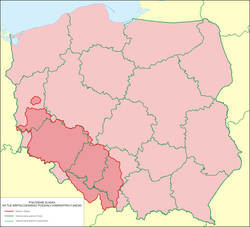
Back Silesië Afrikaans Schlesien ALS سيليزيا Arabic Silesia AST Sileziya Azerbaijani Сілезія Byelorussian Сылезія BE-X-OLD Силезия Bulgarian Silezia Breton Šleska BS
Silesia
| |
|---|---|
| |
 Silesia on a map of Poland | |
 | |
| Coordinates: 51°36′N 17°12′E / 51.6°N 17.2°E | |
| Country | |
| Largest city | Wrocław |
| Former seat | Wrocław (Lower Silesia) Opole (Upper Silesia) |
| Area | |
• Total | 40,400 km2 (15,600 sq mi) |
| Population | |
• Total | c. 8,000,000 |
| • Density | 200/km2 (500/sq mi) |
| Demonym | Silesian |
| GDP | |
| • Total | €150 billion (2022) |
| • Per capita | €18,000 (2022) |
| Time zone | UTC+1 (CET) |
| • Summer (DST) | UTC+2 (CEST) |
Silesia[a] (see names below) is a historical region of Central Europe that lies mostly within Poland, with small parts in the Czech Republic and Germany. Its area is approximately 40,000 km2 (15,400 sq mi), and the population is estimated at 8,000,000. Silesia is split into two main subregions, Lower Silesia in the west and Upper Silesia in the east. Silesia has a diverse culture, including architecture, costumes, cuisine, traditions, and the Silesian language (minority in Upper Silesia). The largest city of the region is Wrocław.
Silesia is situated along the Oder River, with the Sudeten Mountains extending across the southern border. The region contains many historical landmarks and UNESCO World Heritage Sites. It is also rich in mineral and natural resources, and includes several important industrial areas. The largest city and Lower Silesia's capital is Wrocław; the historic capital of Upper Silesia is Opole. The biggest metropolitan area is the Katowice metropolitan area, the centre of which is Katowice. Parts of the Czech city of Ostrava and the German city of Görlitz are within Silesia's borders.
Silesia's borders and national affiliation have changed over time, both when it was a hereditary possession of noble houses and after the rise of modern nation-states, resulting in an abundance of castles, especially in the Jelenia Góra valley. The first known states to hold power in Silesia were probably those of Greater Moravia at the end of the 9th century and Bohemia early in the 10th century. In the 10th century, Silesia was incorporated into the early Polish state, and after its fragmentation in the 12th century it formed the Duchy of Silesia, a provincial duchy of Poland. As a result of further fragmentation, Silesia was divided into many duchies, ruled by various lines of the Polish Piast dynasty. In the 14th century, it became a constituent part of the Bohemian Crown Lands under the Holy Roman Empire, which passed to the Austrian Habsburg monarchy in 1526; however, a number of duchies remained under the rule of Polish dukes from the houses of Piast, Jagiellon and Sobieski as formal Bohemian fiefdoms, some until the 17th–18th centuries. As a result of the Silesian Wars, the region was annexed by the German state of Prussia from Austria in 1742.
After World War I, when the Poles and Czechs regained their independence, the easternmost part of Upper Silesia became again part of Poland by the decision of the Entente Powers after insurrections by Poles and the Upper Silesian plebiscite, while the remaining former Austrian parts of Silesia were divided between Czechoslovakia and Poland. During World War II, as a result of German occupation the entire region was under control of Nazi Germany. In 1945, after World War II, most of the German-held Silesia was transferred to Polish jurisdiction by the Potsdam Agreement between the victorious Allies and became again part of Poland, although with a Soviet-installed communist regime. The small Lusatian strip west of the Oder–Neisse line, which had belonged to Silesia since 1815, became part of East Germany.
As the result of the forced population shifts of 1945–48, today's inhabitants of Silesia speak the national languages of their respective countries. Previously German-speaking Lower Silesia has developed a new mixed Polish dialect and novel costumes. There is ongoing debate about whether the Silesian language, common in Upper Silesia, should be considered a dialect of Polish or a separate language. The Lower Silesian German dialect is nearing extinction due to its speakers' expulsion.
- ^ "EU regions by GDP, Eurostat". Archived from the original on 27 February 2023. Retrieved 18 September 2023.
- ^ "Silesia". The American Heritage Dictionary of the English Language (5th ed.). HarperCollins. Retrieved 23 July 2019.
- ^ "Silesia". Collins English Dictionary. HarperCollins. Retrieved 23 July 2019.
- ^ "Silesia". Lexico UK English Dictionary. Oxford University Press. Archived from the original on 23 July 2019.
- ^ "Silesia". Merriam-Webster.com Dictionary. Merriam-Webster. Retrieved 23 July 2019.
Cite error: There are <ref group=lower-alpha> tags or {{efn}} templates on this page, but the references will not show without a {{reflist|group=lower-alpha}} template or {{notelist}} template (see the help page).







